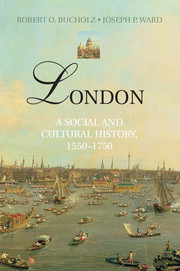Book contents
- Frontmatter
- Contents
- List of Illustrations and Maps
- List of Abbreviations and Conventions
- Acknowledgments
- Maps
- Introduction: London's Importance
- 1 London in 1550
- 2 The Socioeconomic Base
- 3 Royal and Civic London
- 4 Fine and Performed Arts
- 5 The Public Sphere and Popular Culture
- 6 The People on the Margins
- 7 Riot and Rebellion
- 8 Plague and Fire
- Conclusion: London in 1750
- Notes
- Further Reading
- Index
- Plate Section
5 - The Public Sphere and Popular Culture
Published online by Cambridge University Press: 05 November 2012
- Frontmatter
- Contents
- List of Illustrations and Maps
- List of Abbreviations and Conventions
- Acknowledgments
- Maps
- Introduction: London's Importance
- 1 London in 1550
- 2 The Socioeconomic Base
- 3 Royal and Civic London
- 4 Fine and Performed Arts
- 5 The Public Sphere and Popular Culture
- 6 The People on the Margins
- 7 Riot and Rebellion
- 8 Plague and Fire
- Conclusion: London in 1750
- Notes
- Further Reading
- Index
- Plate Section
Summary
It should be obvious that the lines dividing one social or economic group from another in early modern London were porous. Londoners of all ranks frequently had encounters – in church or in the street, at the market or over the shop counter, standing nearby at an outdoor sermon, play, or a bear baiting – with people whose ambitions and sensibilities were quite different from their own. Such interaction, the mixing rather than disintegration of social groups, was a hallmark of metropolitan life in the early modern period. This chapter explores London's tendency to bring people of different backgrounds and ranks together in three contexts: the evolution of the news trade; the proliferation of venues for social interaction such as taverns, coffeehouses, and clubs; and popular cultural formations that often crossed class and gender lines.
News Before Print
The notion of a public press began in Europe in the fifteenth century, in printing centers like Amsterdam and London. For most of our period, however, this was not necessarily a free press in the modern sense; rather, a debate arose between two different kinds of press. Does a national press exist to inform the public of the establishment's “case,” the “official” version put out by the government or Church hierarchy; or should it broadcast the “truth” as its authors see it, independent of governmental or ecclesiastical authority? In early modern England, the power structure favored the former; but the latter erupted periodically and ultimately proved impossible to suppress. The result, aided and abetted by institutions of relatively free social interaction like the coffeehouse, was to create a public sphere of relatively free common discourse whose headquarters was London.
- Type
- Chapter
- Information
- LondonA Social and Cultural History, 1550–1750, pp. 164 - 218Publisher: Cambridge University PressPrint publication year: 2012



